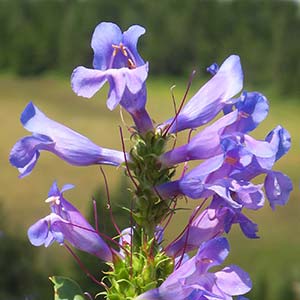Penstemon cardwellii
Penstemon pennellianus
Cardwell's beardtongue
Blue Mountains beardtongue, Pennell's beardtongue
Leaves opposite, glabrous, the largest on short, sterile shoots, serrulate or nearly entire, short-petiolate, the blades elliptic, 1.5-3.5 cm. long and 6-14 mm. wide;
leaves of the flowering shoots less crowded, smaller, sessile and entire.
Leaves opposite, entire, the basal ones clustered, up to 27 cm. long and 4 cm. wide, petiolate, the blade lanceolate or narrowly elliptic;
cauline leaves mostly sessile, broad and clasping.
Inflorescence racemose, few-flowered and crowded, glandular, the simple pedicels opposite and axillary;
calyx 5-12 mm. long, the 5 segments thin and lanceolate;
corolla bright purple to deep blue-violet, 30-38 mm. long, about 1 cm. wide at the mouth, keeled on the back, glabrous outside and with long, white hairs near the base of the lower lip within;
anthers long-wooly, pollen sacs opposite;
staminode slender, shorter than the 4 fertile filaments, long-bearded toward the tip
Inflorescence of several verticillasters;
calyx 5-cleft nearly to the base, 6-9 mm. long, the segments narrow and acuminate;
corolla bilabiate, bright blue, 25-33 mm. long, about 1 cm. wide at the mouth, glabrous;
pollen sacs 1.9-2.5 mm. long, divaricate, twisted, dentate along the sutures, the inner end indehiscent;
fertile stamens 4;
sterile stamen short-bearded toward the tip.
Capsule
Capsule 9-12 mm. long.



